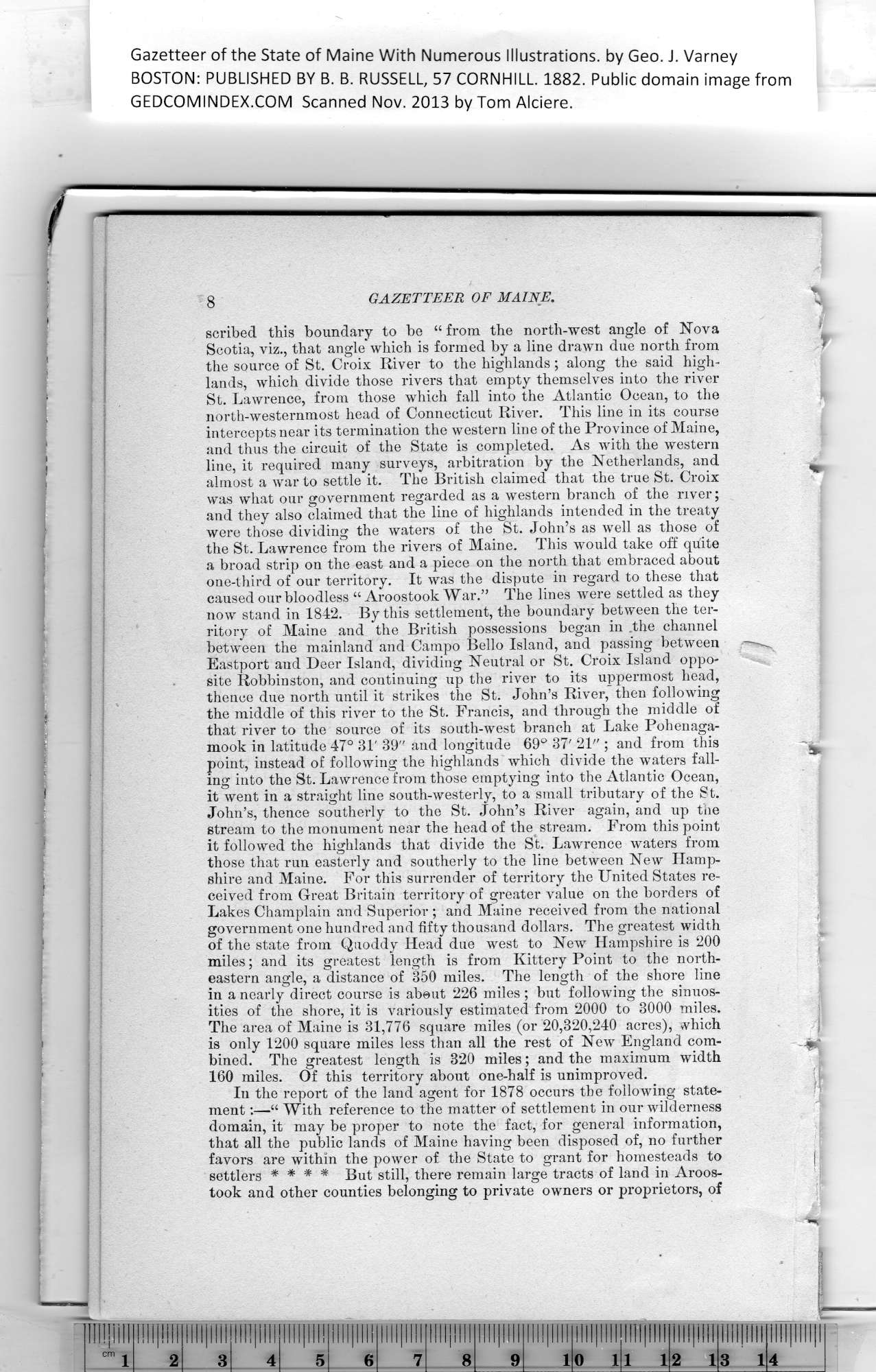8 GAZETTEER OF MAINE.
scribed tbis boundary to be “ from the north-west angle of Nova
Scotia, viz., that angle which is formed by a line drawn due north from
the source of St. Croix River to the highlands ; along the said high¬
lands, which divide those rivers that empty themselves into the river
St. Lawrence, from those which fall into the Atlantic Ocean, to the
north-westernmost head of Connecticut River. This line in its course
intercepts near its termination the western line of the Province of Maine,
and thus the circuit of the State is completed. As with the western
line, it required many surveys, arbitration by the Netherlands, and
almost a war to settle it. The British claimed that the true St. Croix
was what our government regarded as a western branch of the river;
and they also claimed that the line of highlands intended in the treaty
were those dividing the waters of the St. John’s as well as those of
the St. Lawrence from the rivers of Maine. This would take off quite
a broad strip on the east and a piece on the north that embraced about
one-third of our territory. It was the dispute in regard to these that
caused our bloodless “ Aroostook War.” The lines were settled as they
now stand in 1842. By this settlement, the boundary between the ter¬
ritory of Maine and the British possessions began in the channel
between the mainland and Campo Bello Island, and passing between
Eastport and Deer Island, dividing Neutral or St. Croix Island oppo¬
site Robbinston, and continuing up the river to its uppermost head,
thence due north until it strikes the St. John’s River, then following
the middle of this river to the St. Francis, and through the middle of
that river to the source of its south-west branch at Lake Pohenaga-
mook in latitude 47° 31' 39" and longitude 69° 37’ 21" ; and from this
point, instead of following the highlands which divide the •waters fall¬
ing into the St. Lawrence from those emptying into the Atlantic Ocean,
it went in a straight line south-westerly, to a small tributary of the St.
John’s, thence southerly to the St. John’s River again, and up the
stream to the monument near the head of the stream. From this point
it followed the highlands that divide the St. Lawrence waters from
those that run easterly and southerly to the line between New Hamp¬
shire and Maine. For this surrender of territory the United States re¬
ceived from Great Britain territory of greater value on the borders of
Lakes Champlain and Superior ; and Maine received from the national
government one hundred and fifty thousand dollars. The greatest width
of the state from Quoddy Head due west to New Hampshire is 200
miles; and its greatest length is from Kittery Point to the north¬
eastern angle, a distance of 350 miles. The length of the shore line
in a nearly direct course is about 226 miles ; but following the sinuos¬
ities of the shore, it is variously estimated from 2000 to 3000 miles.
The area of Maine is 31,776 square miles (or 20,320,240 acres), vhich
is only 1200 square miles less than all the rest of New England com¬
bined. The greatest length is 320 miles; and the maximum width
160 miles. Of this territory about one-half is unimproved.
In the report of the land agent for 1878 occurs tbe following state¬
ment :—“ With reference to the matter of settlement in our wilderness
domain, it may be proper to note the fact, for general information,
that all the public lands of Maine having been disposed of, no further
favors are within the power of the State to grant for homesteads to
settlers * # # # But still, there remain large tracts of land in Aroos¬
took and other counties belonging to private owners or proprietors, of
PREVIOUS PAGE ...
NEXT PAGE
This page was written in HTML using a program written in Python 3.2
|
